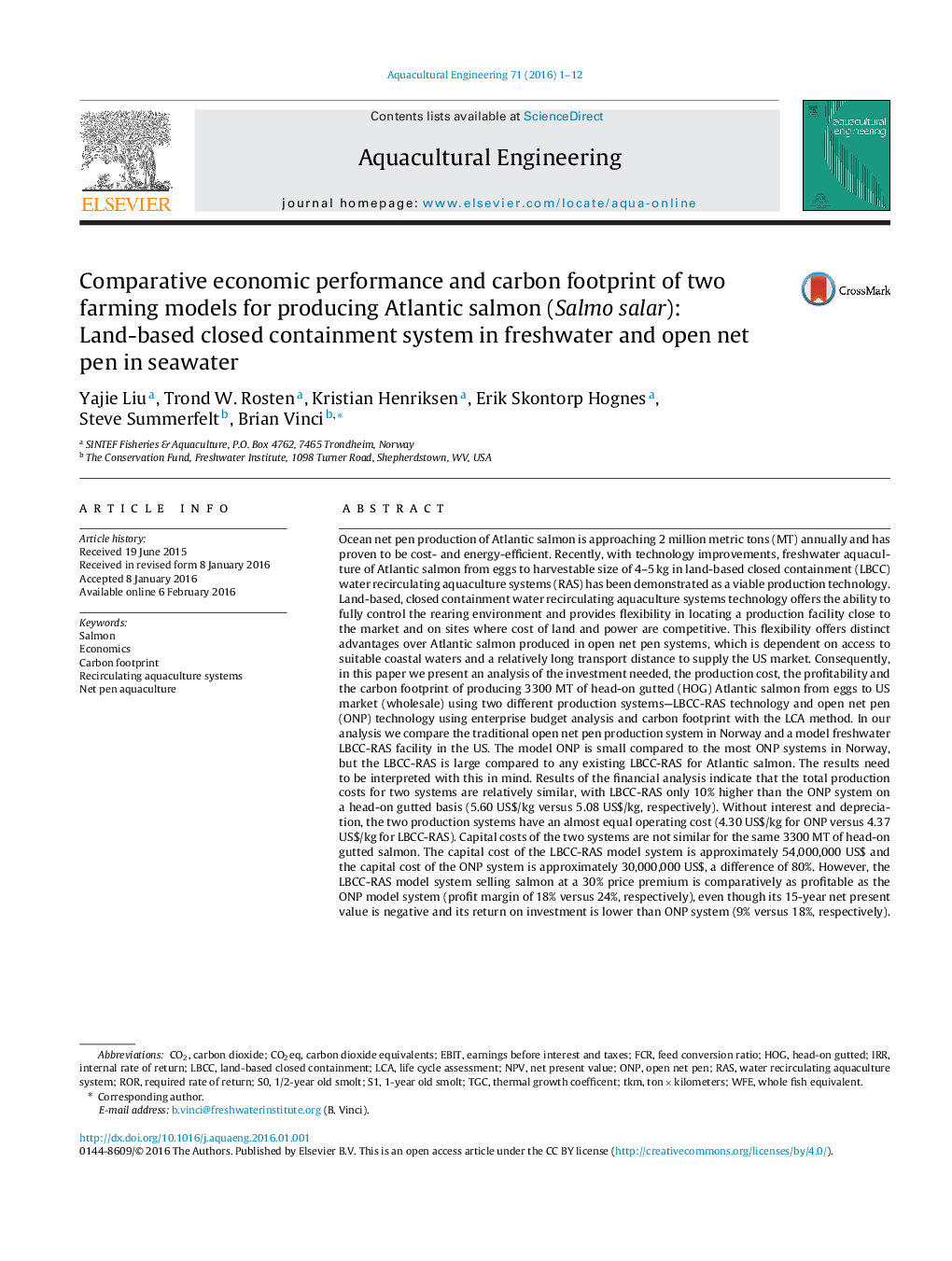| کد مقاله | کد نشریه | سال انتشار | مقاله انگلیسی | نسخه تمام متن |
|---|---|---|---|---|
| 6381264 | 1625699 | 2016 | 12 صفحه PDF | دانلود رایگان |
عنوان انگلیسی مقاله ISI
Comparative economic performance and carbon footprint of two farming models for producing Atlantic salmon (Salmo salar): Land-based closed containment system in freshwater and open net pen in seawater
دانلود مقاله + سفارش ترجمه
دانلود مقاله ISI انگلیسی
رایگان برای ایرانیان
کلمات کلیدی
FCRCO2eqEBITTKMONPTGCIRRRASRORnet present value - ارزش خالص فعلیLCA - ارزیابی چرخه حیاتLife Cycle Assessment - ارزیابی چرخه عمر یا چرخه حیاتHog - تیراندازیCarbon dioxide - دیاکسید کربنCarbon footprint - ردپای کربنRecirculating aquaculture systems - سیستم های آبزی پرورش مجددEconomics - علم اقتصادSalmon - ماهی سالمونCarbon dioxide equivalents - معادل دی اکسید کربنNPV یا negative predictive value - مقادیر پیش بینی شده منفیInternal rate of return - نرخ بازده داخلیfeed conversion ratio - نسبت تبدیل خوراکCO2 - کربن دیاکسید
موضوعات مرتبط
علوم زیستی و بیوفناوری
علوم کشاورزی و بیولوژیک
علوم آبزیان
پیش نمایش صفحه اول مقاله

چکیده انگلیسی
Ocean net pen production of Atlantic salmon is approaching 2 million metric tons (MT) annually and has proven to be cost- and energy-efficient. Recently, with technology improvements, freshwater aquaculture of Atlantic salmon from eggs to harvestable size of 4-5Â kg in land-based closed containment (LBCC) water recirculating aquaculture systems (RAS) has been demonstrated as a viable production technology. Land-based, closed containment water recirculating aquaculture systems technology offers the ability to fully control the rearing environment and provides flexibility in locating a production facility close to the market and on sites where cost of land and power are competitive. This flexibility offers distinct advantages over Atlantic salmon produced in open net pen systems, which is dependent on access to suitable coastal waters and a relatively long transport distance to supply the US market. Consequently, in this paper we present an analysis of the investment needed, the production cost, the profitability and the carbon footprint of producing 3300 MT of head-on gutted (HOG) Atlantic salmon from eggs to US market (wholesale) using two different production systems-LBCC-RAS technology and open net pen (ONP) technology using enterprise budget analysis and carbon footprint with the LCA method. In our analysis we compare the traditional open net pen production system in Norway and a model freshwater LBCC-RAS facility in the US. The model ONP is small compared to the most ONP systems in Norway, but the LBCC-RAS is large compared to any existing LBCC-RAS for Atlantic salmon. The results need to be interpreted with this in mind. Results of the financial analysis indicate that the total production costs for two systems are relatively similar, with LBCC-RAS only 10% higher than the ONP system on a head-on gutted basis (5.60 US$/kg versus 5.08 US$/kg, respectively). Without interest and depreciation, the two production systems have an almost equal operating cost (4.30 US$/kg for ONP versus 4.37 US$/kg for LBCC-RAS). Capital costs of the two systems are not similar for the same 3300 MT of head-on gutted salmon. The capital cost of the LBCC-RAS model system is approximately 54,000,000 US$ and the capital cost of the ONP system is approximately 30,000,000 US$, a difference of 80%. However, the LBCC-RAS model system selling salmon at a 30% price premium is comparatively as profitable as the ONP model system (profit margin of 18% versus 24%, respectively), even though its 15-year net present value is negative and its return on investment is lower than ONP system (9% versus 18%, respectively). The results of the carbon footprint analysis confirmed that production of feed is the dominating climate aspect for both production methods, but also showed that energy source and transport methods are important. It was shown that fresh salmon produced in LBCC-RAS systems close to a US market that use an average US electricity mix have a much lower carbon footprint than fresh salmon produced in Norway in ONP systems shipped to the same market by airfreight, 7.41 versus 15.22Â kg CO2eq/kg salmon HOG, respectively. When comparing the carbon footprint of production-only, the LBCC-RAS-produced salmon has a carbon footprint that is double that of the ONP-produced salmon, 7.01 versus 3.39Â kg CO2eq/kg salmon live-weight, respectively.
ناشر
Database: Elsevier - ScienceDirect (ساینس دایرکت)
Journal: Aquacultural Engineering - Volume 71, March 2016, Pages 1-12
Journal: Aquacultural Engineering - Volume 71, March 2016, Pages 1-12
نویسندگان
Yajie Liu, Trond W. Rosten, Kristian Henriksen, Erik Skontorp Hognes, Steve Summerfelt, Brian Vinci,